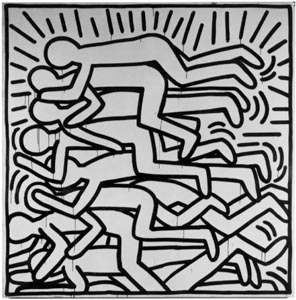
A rave revue at MOMA celebrated the master of street art
By Michelle Goldberg
Pop, a party celebrating the Keith Haring exhibit at the MOMA, replicated at least one element of New York nightlife's heyday: the lines. Those who lacked the foresight to buy tickets in advance were forced to stand in a massive queue that stretched around a side of the building. Ticket-holders didn't fare much better--some had to wait up to an hour to get in, and an hour teetering in high heels and a gauzy cocktails dress goes by slower than an episode of Ally McBeal. By the time the party ended, I was feeling like Elizabeth Wurtzel.
Despite the Haring tie-in, Pop was essentially a rave in the MOMA atrium. The only reference to the '80s were consoles with old computer games sponsored by the Bureau of Low Technology. The rest was pure '90s--throbbing techno, video non sequiturs, trippy computer animation. There was no graffiti art, no break-dancing, no old hiphop or new wave music--in short, nothing that one would expect at a party intended to honor an artist whose low-tech exuberance was, despite its universal appeal, deeply rooted in a specific New York milieu. In a way, Pop was the logical extension of Keith Haring's project: Haring brought street art to the galleries, while Pop made club culture itself a museum piece. At the same time, strolling around the fourth-floor exhibit (by far the best part of the party was getting to see Haring's work at night with pumping music and no tourists), it was striking how much Haring's vital, kinetic paintings, with their joyous immediacy and political passion, contrasted to the rather cold, alienating scene below.
In the atrium, a few people in '80s drag mingled with b-boys, rave kids and hordes of lovely people in designer clothes. A jungle room featured, in addition to the old-school video games, a bunch of net-surfing terminals hosted by SF Station. The most striking people at the party were Etoy, a seven-man posse of art shysters that look like white-power skinhead robots. The international group--Mark, Carl, Hans, Taki, Jack, Dave and Matt--are bald and dress entirely in black except for day-glo orange, zip-front bomber jackets adorned with the logos of sponsoring companies like Sun Microsystems. Painfully postmodern, Etoy has invented itself as an art commodity, even selling shares in themselves. "The shareholder is the pop star," says their Web site. I tried to talk to Carl, but he just handed me a plastic business card and said that they only communicate via email. One can only wonder what Haring--devoutly and earnestly political as he was--would make of their cynical techno-fetishist shtick.
I first heard of Etoy through an email from ®™ark (pronounced art mark), an underground group of corporate saboteurs who offer grants to art pranksters. They paid local programmer Jacques Servin $5,000 to insert homoerotic scenes into the SimCopter video game and are offering, among many other prizes, "$1,000 to a worker at a major metropolitan newspaper who significantly alters an issue in an interesting way." One of the Etoy boys, I think it was Hans, broke his silence to tell me that a member of ®™ark was in attendance. I've been corresponding with the group for months online, and I begged him to introduce me. Toward the end of the night, I was outside smoking amid a group of kids lounging on the ground drinking 40s when Hans obligingly pointed me out to my anonymous pen pal.
"If I were a kid, and I came here to see what people were doing and I saw everyone sitting around playing video games, I'd try to fight it," said the ®™ark member. He was unimpressed with the party as a whole: "Nobody looked like they were enjoying it. ®™ark is against it. ®™ark thinks this whole thing is really stupid, completely 100 percent mind-boggling. There are 20 million different levels to how stupid this is."
Not everyone agreed, of course--a boy who designs rave and skate T-shirts said, "How could you not have a good time? You have world-class DJs, a great exhibit, a combination of all the great arts." But still, something about the event bothered me. Maybe it was all the people staring at the computer screens instead of at each other. A stripper at Chez Paree tells me that the club now has Internet terminals for all the high-tech workers who unwind there, and that even though they're surrounded by naked girls they still sit and surf the web. Surely Haring, who often painted televisions as ghouls and enemy tools, would be disheartened to know that a similar thing was happening at a party in his honor.
[ San Francisco | MetroActive Central | Archives ]
![[MetroActive Arts]](/arts/gifs/art468.gif)